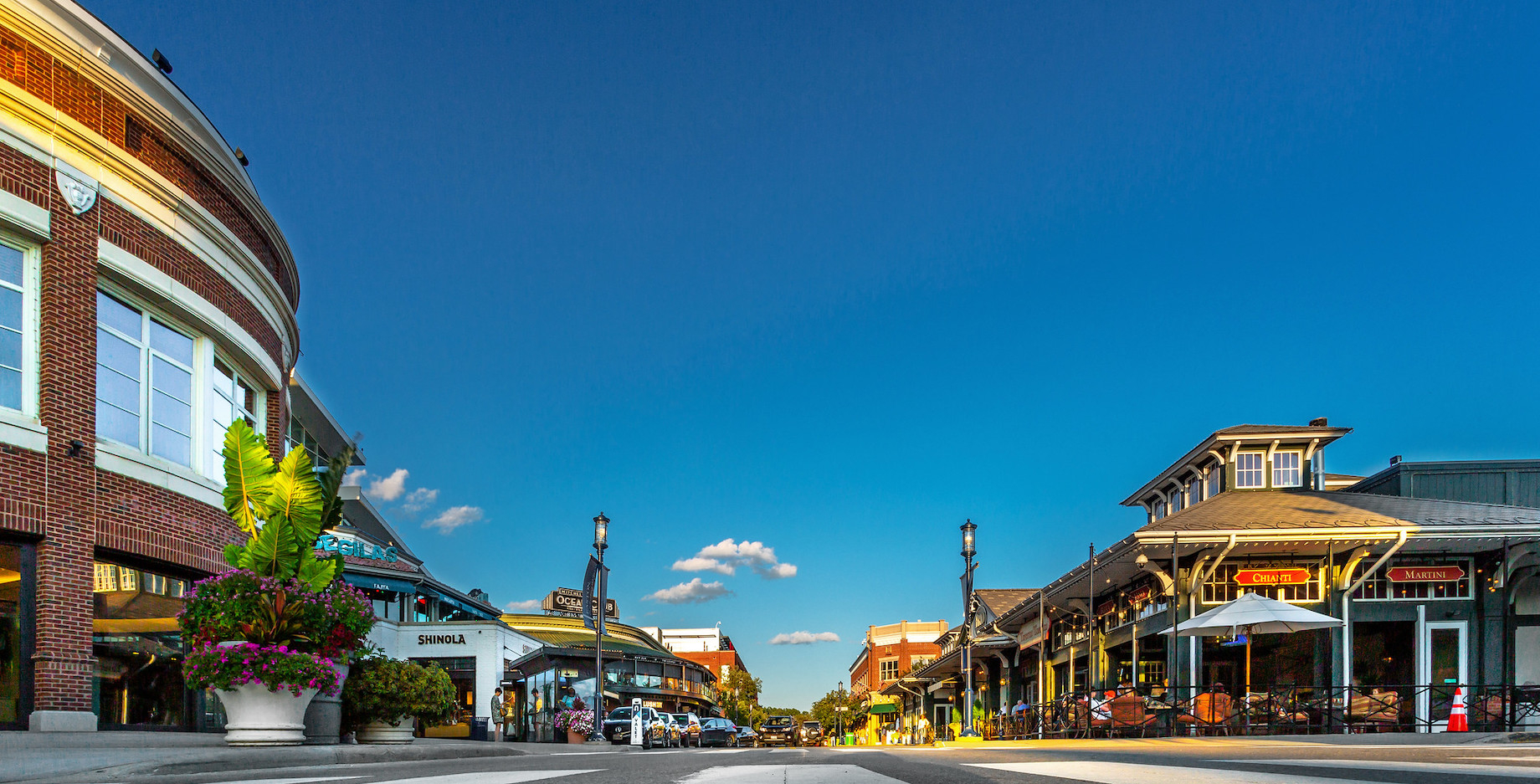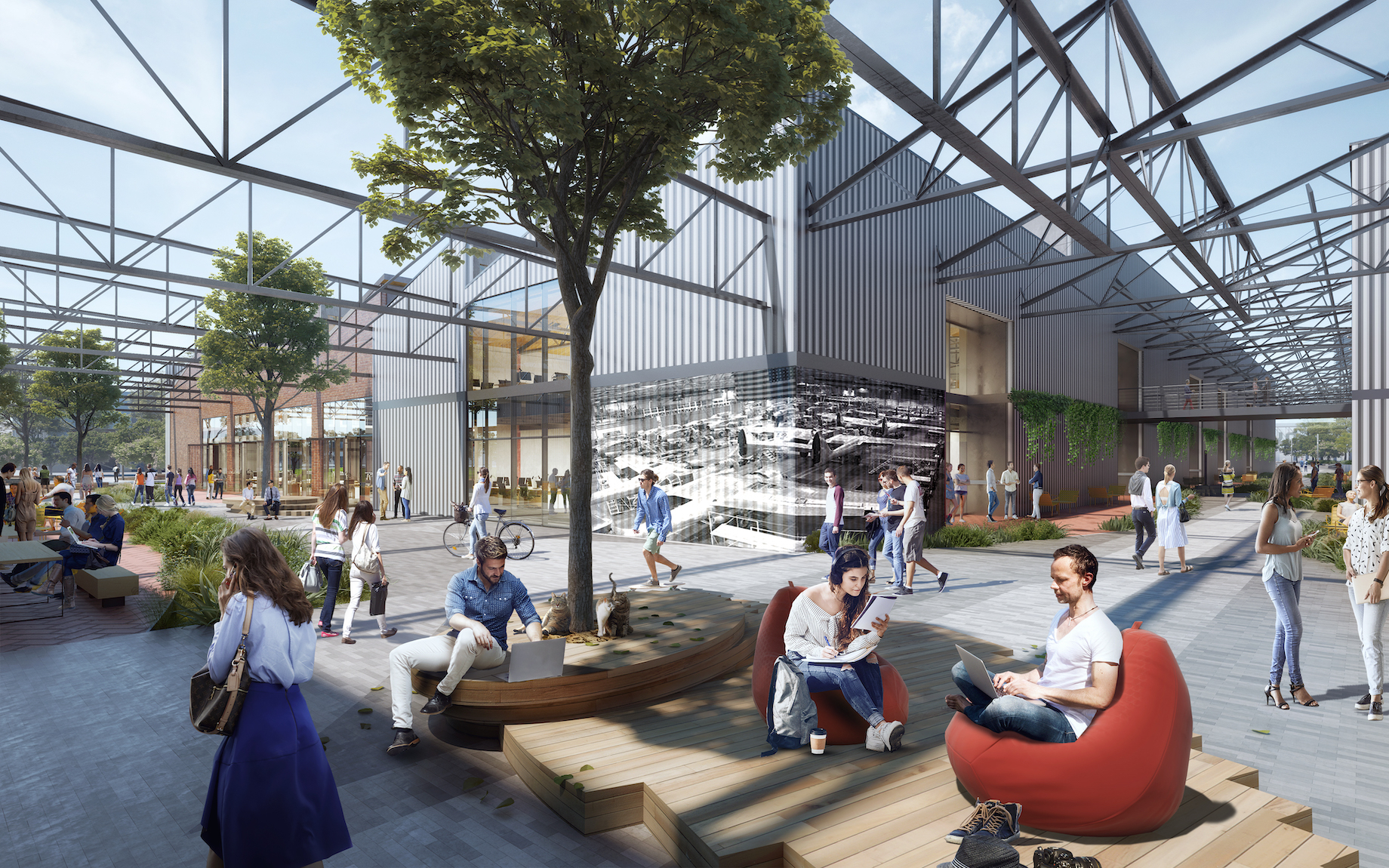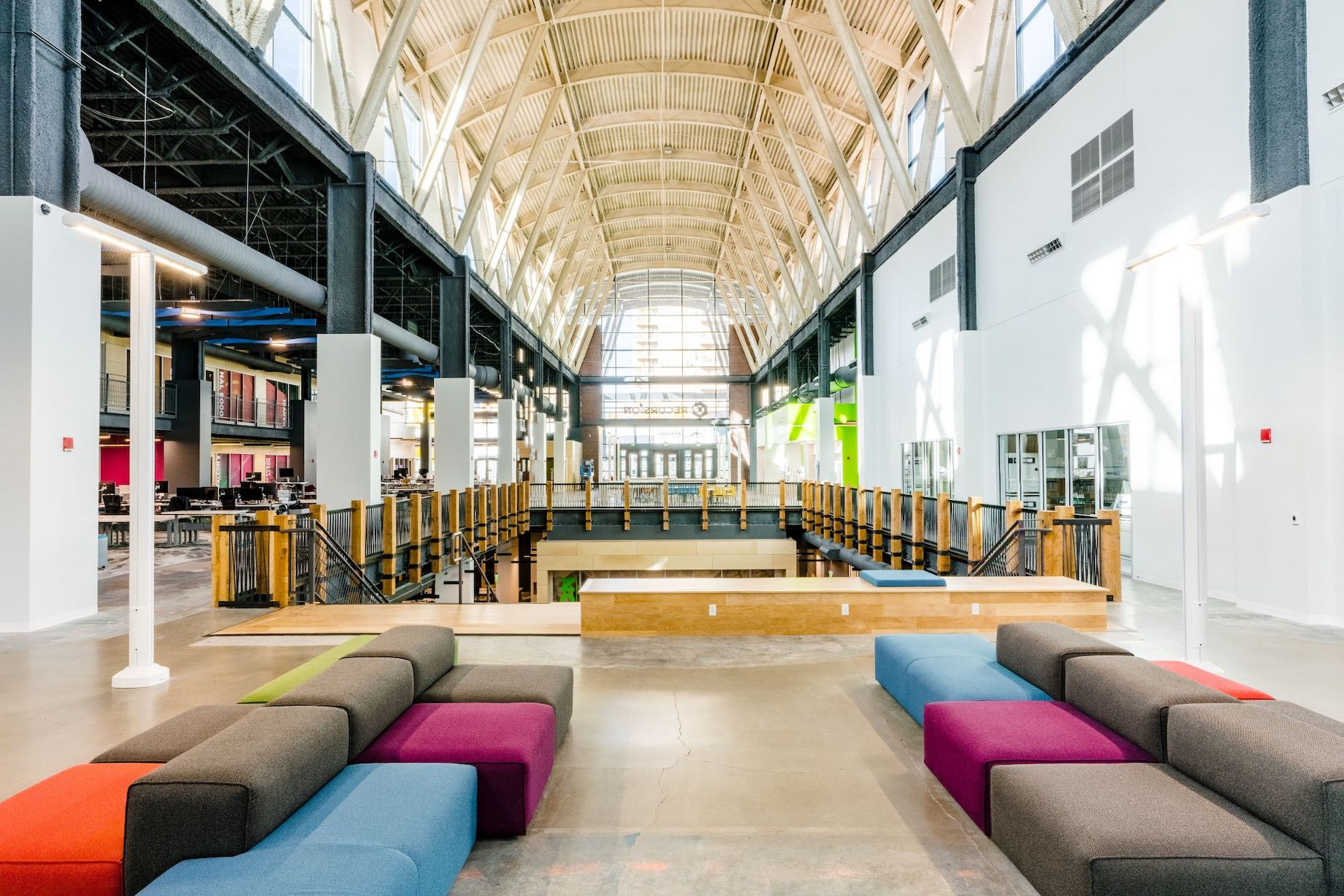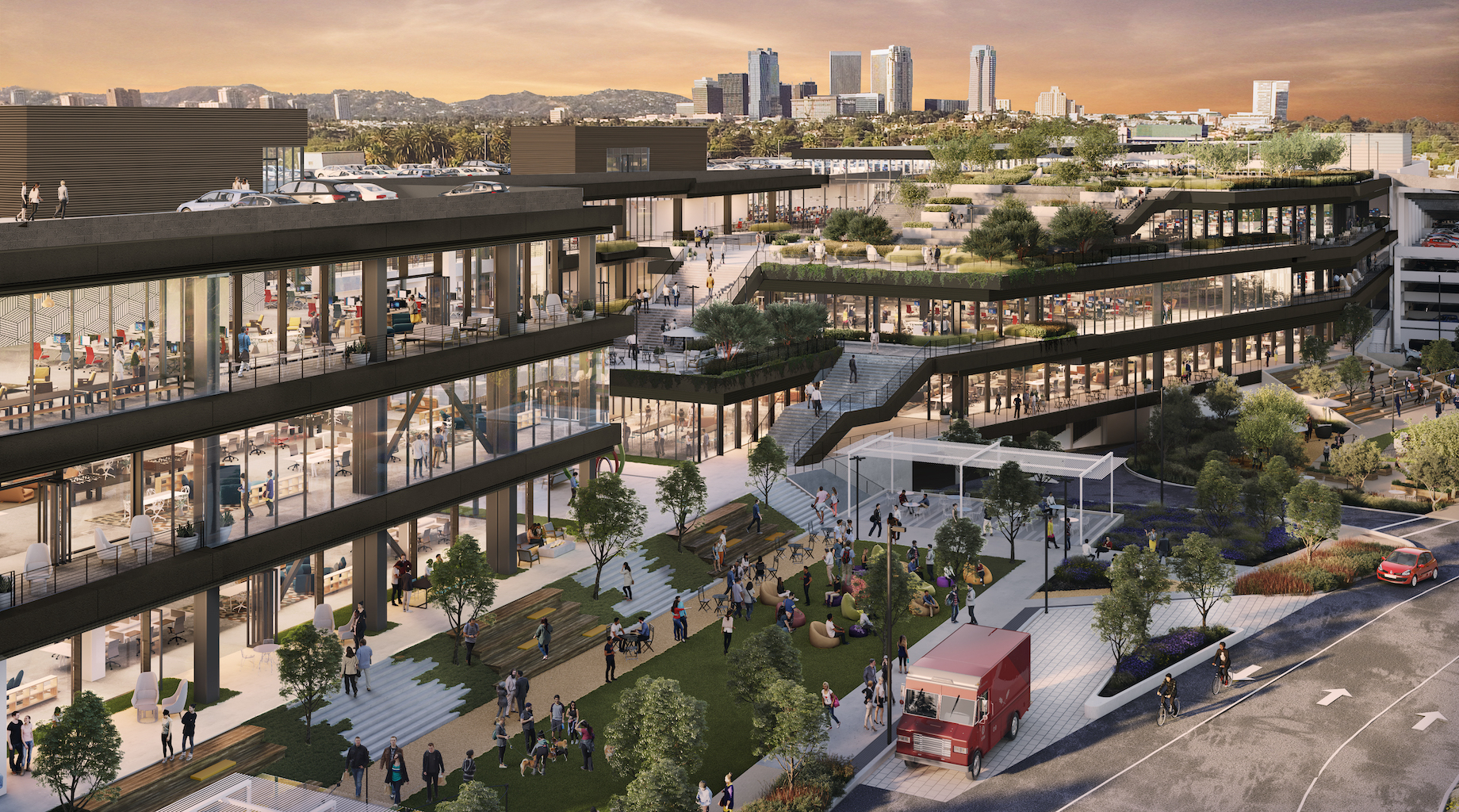Not so long ago, a humdrum industrial park out of the TV show The Office was good enough for many employers. But more companies now aim to put their HQs and offices next to hubs of commerce that offer bars, restaurants, entertainment venues and other things to do. And that trend is creating leasing opportunities for retail owners and developers. “Employee recruiting and retention has become so competitive,” said Steiner executive vice president of asset performance Beau Arnason. “Employers are saying, ‘Wow, we’ve got to do more for our employees.’ Companies want to offer their employees a better place to work.”
Arnason cites M/I Homes’ headquarters relocation last year. The homebuilder sold its five-story building within Steiner’s 1,300-acre Easton master-planned community in Columbus, Ohio, just to move a quarter mile closer to Easton’s downtown-inspired district. “It was a short distance but a huge environment change,” he said. “It put them right in the core of that pedestrian environment with all of those amenities.” Now, those employees can step out of their new HQ on Worth Avenue and stroll to the likes of Dragon Donuts, True Food Kitchen, RH’s rooftop restaurant or Condado taco restaurant. “It’s the difference between driving to Starbucks versus just walking down the stairs,” Arnason said. “Normally, an office user would not move such a short distance, but M/I Homes saw the value.”

M/I Homes moved within Columbus, Ohio’s Easton to be closer to the master-planned community’s downtown district, pictured above. Its new headquarters is pictured at top.
“Future-proofed” HQs in Texas
When Toyota wanted to move 2,800 people from different North American offices to a massive new HQ called Toyota One, the carmaker could have saved money by locating in a conventional industrial park. Instead, it put that 100-acre campus in the middle of a fast-growing Texas suburb, along the border of Plano and Frisco. Toyota One is less than two miles from a commercial district packed with retail, dining and entertainment options, including at the major mixed-use destinations Legacy West and Legacy Town Center. Residential developments are part of the local mix, as well, making for an easy commute for employees. “Toyota was very smart in its site selection for the campus,” said Concept Commercial Realty vice president of real estate Jimmy Pham. “Just based on that location, Toyota future-proofed themselves as far as being able to grab and retain employees.”
Now the market is buzzing about the impending opening of PGA of America’s HQ in Frisco, Pham said. Currently based in an office building in Palm Beach Gardens, Florida, the golf association wants its new HQ to be the center of a recreational and commercial hub. According to a press release, it will anchor a 600-acre, mixed-use project designed to “deliver innovative and differentiated experiences for our nearly 29,000 PGA golf professionals, golfers of all abilities and our staff.” The $520 million project is under construction. It will include a retail village, a 500-room resort, golf courses, a clubhouse and “Class AA” offices. Two PGA Championships and two KPMG Women’s PGA Championships are among the events scheduled for the site.
New El Segundo HQs: Beyond Meat and L’Oreal USA
Lower taxes and competitive occupancy costs are part of how El Segundo, California, this year landed the corporate HQs of L’Oreal USA and Beyond Meat. But as Mayor Drew Boyles sees it, the mix of things to do in the neighborhood was a major factor, as well.
Both companies are moving to Hackman Capital Partners’ reboot of a former aerospace and warehousing area at 888 N. Douglas St. This past January, Hackman announced it had signed a 12-year lease with Beyond Meat for 280,000 square feet at the 390,000-square-foot “high-end creative workspace.” The project also will include L’Oreal USA’s 100,000-square-foot, second American HQ, supplementing its Manhattan location. In the deal announced in April, L’Oreal USA said it will use the West Coast HQ to bring together teams from its four California-based brands and create an on-site academy for salon professionals, hairstylists and makeup artists.
The mayor described Hackman’s project as “spectacular creative office space.” Highlighting today’s emphasis on engaging workplaces, the building offers 45-foot ceilings with huge windows to bring in natural light, along with outdoor patios and amenities like a fitness center, a cafeteria and leafy-green interior “living walls.”

L'Oreal and Beyond Meat are moving in to Hackman Capital Partners' 888 N. Douglas St. in El Segundo, California. Photo credit: Hackman Capital Partners and Gensler
As noted by Boyles, the neighborhood right around 888 N. Douglas boasts the Los Angeles Lakers’ HQ, practice facility and team store; the Los Angeles Air Force Base, which includes the HQ of the U.S. Space Force; and mixed-use projects like Elevon at Campus El Segundo. Nearby food-and-beverage outlets include Bowlology, Starbucks, Noah’s NY Bagels, Grill by Petros, Kaya Sushi and the AC Hotel’s rooftop bar and restaurant. “You’re going to see a whole new spur of growth for retail and restaurants around 888 N. Douglas, in part because L’Oreal and Beyond Meat will be bringing in a minimum of 1,500 new jobs,” the mayor said.
“Bumpability” in Salt Lake City
When it opened in Salt Lake City in 2001, The Gateway was a downtown mall known for an 80-tenant roster including California Pizza Kitchen, Abercrombie & Fitch, Sur La Table and J.Crew. Vestar bought the 1.5 million-square-foot property in 2015 and repositioned it as a mixed-use district, adding attractions like an upscale boutique hotel and the state’s first Dave & Buster’s.
The goal was to lease vacant retail and other spaces to tech startups that were flocking to Salt Lake from high-cost Silicon Valley, said vice president of leasing Jenny Cushing. But instead, Vestar in 2018 took The Gateway in a new direction by leasing its 100,000-square-foot, former Dick’s Sporting Goods to a small biotech firm called Recursion, which wanted to relocate its HQ to Salt Lake. As the life sciences sector took off, a trend the pandemic only accelerated, Recursion grew right along with it. This year, the company moved within The Gateway in order to double the size of its HQ, research and lab space. “Recursion is a newly public company, and we have now leased over 200,000 square feet to them at The Gateway,” Cushing said. “They’ve become a leader in the life sciences sector.”

Recursion’s new and bigger headquarters in The Gateway in Salt Lake City
The fun and convenience of the 21-acre mixed-use project was a big part of the appeal for Recursion, which had started off in a research park, Cushing noted. In addition to tenants like Dave & Buster’s, The Gateway offers Salt Lake City’s largest outdoor art gallery, as well as a food hall, live music venue, planetarium, megaplex theater and children’s museum. “Life sciences companies are realizing that having these kinds of amenities is a good recruitment tool.”
Now, The Gateway stands to benefit from a public-private push to create a healthcare innovation corridor in its neighborhood on the west side of Salt Lake City. More than 1,000 companies in sectors like biopharma, medical devices, diagnostics, genomics and biotech are part of the effort, dubbed BioHive. “The Gateway is positioned as the epicenter of this campus,” Cushing noted. “A significant proportion of the industrial area surrounding the project is being earmarked for life science, and to support that growth, multiple multifamily residential developments are either opened or underway. As a result of BioHive, Utah now leads the nation in job growth in the life sciences and digital health sectors.”
Life sciences companies like Recursion eventually will occupy at least half of The Gateway’s 600,000-square-foot, formerly retail-only component, Cushing said. And as the talent pool of scientists and researchers evolves along with the area, this only will increase the allure of The Gateway among these companies. “The CEO of Recursion also told me they’re looking for the ‘bumpability factor,’” Cushing said. “They want to be in an environment where scientists and like-minded individuals can bump into each other and strategize over a beer.”
Retail-to-office conversions
As employers relocate their HQs to dense hubs with mixes of uses, those who own and develop retail and other properties stand to benefit from new leasing opportunities. “While it’s not an issue at Easton, there’s a lot of well-located retail out there that is beyond its useful life,” Arnason said. “For example, a mall surrounded by mixed-use projects could be a good site for a corporate headquarters relocation.”
And indeed, tech companies and real estate firms already are repurposing malls for offices and HQs: In 2019, Hudson Pacific Properties and Macerich announced that Google had signed a 14-year lease for their entire 584,000-square-foot One Westside redevelopment. The new, Class A office campus replaces part of Los Angeles’ Westside Pavilion mall.

Google is leasing a redevelopment of a large chunk of Los Angeles’ Westside Pavilion mall.
The design, by architecture firm Gensler, puts a strong emphasis once again on the employee experience. As noted in a press release, it includes high ceilings, a multilevel atrium and skylight, “hyperflexible” open layouts and exterior terraces and patios with folding glass walls. The rooftop will feature a garden deck with bridge access to the Landmark Theatre and nearby retail shops. The project is on track for a first-quarter delivery, according to a spokesperson. Macerich and Hudson Pacific will continue to operate 96,000 square feet of adjacent entertainment and retail.
And this past January, Epic Games, the company behind the globally popular video game Fortnite, made a similar move by acquiring North Carolina’s Cary Towne Center for $95 million. The videogame developer reportedly will bring thousands of employees to the former mall and has filed permits for its own mixed-use redevelopment of the property.
Could mall takeovers of this type hurt other businesses by reducing traffic and sales in the submarket? Farbman Group executive vice president Ron Goldstone said that is a faulty assumption. “Having a headquarters backfill an empty mall doesn’t necessarily block retail in that area from growing and expanding,” he said. “Let’s say you’re in a particular market that has three troubled malls. If two of those malls get gobbled up by corporate HQs, the third may do better because of the injection of people in that area. … In my view, nothing is smarter than taking existing, vertically improved assets and coming up with creative ways to reuse them. I cannot emphasize it enough.”
“Nothing is smarter than taking existing, vertically improved assets and coming up with creative ways to reuse them.”
But for such new approaches to take root, municipalities need to be flexible. All too often, Goldstone said, government officials will insist on retail-only replacements, possibly because they fear an erosion of sales tax revenue. “It’s in the best interest of everyone to roll up their sleeves, get creative and work together,” he said. “When you do that, you can have good landings on some of these otherwise-challenged assets.” The Ford Motor Co.’s office relocation to Fairlane Town Center in Dearborn, Michigan, is one example. The 10-year deal, reached in 2017, brought about 1,800 Ford employees to 240,000 square feet of repurposed mall space, including the former Lord & Taylor. “It was a very smart reuse of an anchor,” Goldstone said.
As Cushing sees it, retail landlords, too, may need to show some flexibility as they pivot to lease space to new users like biotech firms and life sciences companies. At The Gateway, for example, Vestar has positioned former retail spaces to serve these tenants by consulting with engineers and other experts to make sure they have the right specs, including industry-standard ventilation systems and floor-load capacities that are sufficient to support the weight of scientific equipment. “It’s important to understand that speaking life sciences is fundamentally different than speaking retail,” she said.
Real estate benefits
In addition to new leasing revenue and higher traffic, corporate HQs can bring other advantages to owners and developers. For starters, they tend to have high lease-renewal rates. “Their employees just don’t want to go back to being in a suburban office park,” Arnason said. Some of these new lessees may invest heavily in these spaces, which supports higher lease-renewal rates, as well. It’s why the life sciences companies in Utah are entertaining lease deals of 10 years or more, Cushing explained. Also, she said, “scientists can’t work from home. They need to come to that lab space, which means you have highly paid, highly educated people with disposable income patronizing your project.”
Thanks to the opportunities these employer trends are creating, Vestar, for one, now puts a premium on creativity in repositioning retail assets. Had the company insisted on sticking with retail-only tenants, that Dick’s Sporting Goods in downtown Salt Lake City could be sitting empty. Instead, Vestar’s openness to the life sciences sector launched a whole new direction for The Gateway and its environs. “We want to avoid being myopic or pigeonholed in any way,” Cushing said. “In our view, being nimble is what will ensure the success of our company and the projects we touch.”
By Joel Groover
Contributor, Commerce + Communities Today